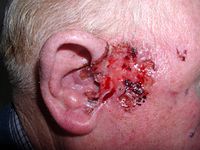
Radiotherapy vs surgery for T1‐2N0M0 laryngeal squamous cell carcinoma: A population‐based and propensity score matching study
Sign Up to like & getrecommendations! Published in 2018 at "Cancer Medicine"
DOI: 10.1002/cam4.1525
Abstract: There are conflicting reports about whether radiotherapy or surgery is optimal for early‐stage laryngeal squamous cell carcinoma (LSCC), although both have recently been recommended. Patients with T1‐2N0M0 LSCC in the population‐based SEER database who underwent… read more here.
Keywords: surgery; cell carcinoma; squamous cell; radiotherapy surgery ... See more keywords

Tumor suppression effect of targeting periostin with siRNA in a nude mouse model of human laryngeal squamous cell carcinoma
Sign Up to like & getrecommendations! Published in 2019 at "Journal of Clinical Laboratory Analysis"
DOI: 10.1002/jcla.22622
Abstract: The incidence of laryngeal carcinoma is increasing, however, the mechanism is not fully understood. We aimed to investigate the efficacy of periostin gene silencing by siRNA on tumor inhibition, in a novel nude mouse model… read more here.
Keywords: nude mouse; laryngeal squamous; carcinoma; human laryngeal ... See more keywords

tRNAIni CAT inhibits proliferation and promotes apoptosis of laryngeal squamous cell carcinoma cells
Sign Up to like & getrecommendations! Published in 2021 at "Journal of Clinical Laboratory Analysis"
DOI: 10.1002/jcla.23821
Abstract: Laryngeal squamous cell carcinoma (LSCC) brings a heavy blow to the patient's voice. Transfer RNA (tRNA) is a common RNA, the roles of tRNAs in LSCC are largely unknown. read more here.
Keywords: squamous cell; trnaini cat; cell carcinoma; laryngeal squamous ... See more keywords

A prognostic nomogram for predicting risk of recurrence in laryngeal squamous cell carcinoma patients after tumor resection to assist decision making for postoperative adjuvant treatment
Sign Up to like & getrecommendations! Published in 2019 at "Journal of Surgical Oncology"
DOI: 10.1002/jso.25614
Abstract: This study aimed to create a nomogram for postoperative prediction of the risk of recurrence in laryngeal squamous cell carcinoma patients who received laryngectomy alone and to assess indications for postoperative adjuvant treatments (POAT). read more here.
Keywords: cell carcinoma; squamous cell; risk recurrence; carcinoma patients ... See more keywords

Treatment and outcome among patients with laryngeal squamous cell carcinoma in Stockholm—A population‐based study
Sign Up to like & getrecommendations! Published in 2023 at "Laryngoscope Investigative Otolaryngology"
DOI: 10.1002/lio2.1034
Abstract: Survival of patients with advanced laryngeal squamous cell carcinoma (LSCC) remains poor and management protocols warrant further development. We thus investigated treatment and outcome‐related factors for LSCC in Stockholm, Sweden. read more here.
Keywords: cell carcinoma; squamous cell; treatment outcome; laryngeal squamous ... See more keywords

CircBFAR correlates with poor prognosis and promotes laryngeal squamous cell cancer progression through miR‐31‐5p/COL5A1 axis
Sign Up to like & getrecommendations! Published in 2022 at "Laryngoscope Investigative Otolaryngology"
DOI: 10.1002/lio2.966
Abstract: Laryngeal squamous cell cancer (LSCC) is a highly malignant tumor originating from the respiratory system. Circular RNAs have been reported to be associated with the treatment and prognosis of a variety of cancers, including LSCC. read more here.
Keywords: cell cancer; squamous cell; prognosis; laryngeal squamous ... See more keywords

Identification of miR‐145‐5p‐Centered Competing Endogenous RNA Network in Laryngeal Squamous Cell Carcinoma
Sign Up to like & getrecommendations! Published in 2019 at "PROTEOMICS"
DOI: 10.1002/pmic.201900020
Abstract: This study intends to investigate the transcriptional regulatory role of miR‐145‐5p in laryngeal squamous cell carcinoma (LSCC). LSCC cell line TU‐177 is transfected with miR‐145‐5p mimics, generating miR‐145‐5p‐overexpression LSCC cells. Whole transcriptome microarrays are used… read more here.
Keywords: cell; mir 145; cell carcinoma; squamous cell ... See more keywords

Autophagy suppression enhances DNA damage and cell death upon treatment with PARP inhibitor Niraparib in laryngeal squamous cell carcinoma
Sign Up to like & getrecommendations! Published in 2019 at "Applied Microbiology and Biotechnology"
DOI: 10.1007/s00253-019-10148-y
Abstract: Although poly (ADP-ribose) polymerase (PARP) inhibitors, as anti-tumor drugs targeting the DNA damage response (DDR), have been used for the therapy of various tumors, few researches reported their effect on laryngeal squamous cell carcinoma (LSCC).… read more here.
Keywords: dna damage; cell; cell carcinoma; squamous cell ... See more keywords

Increased mu-opioid receptor expression is associated with reduced disease-free and overall survival in laryngeal squamous cell carcinoma.
Sign Up to like & getrecommendations! Published in 2020 at "British journal of anaesthesia"
DOI: 10.1016/j.bja.2020.07.051
Abstract: BACKGROUND Expression of the mu-opioid receptor (MOR) is associated with poor long-term outcomes in various types of cancer. The association between MOR expression and clinical outcomes in laryngeal squamous cell carcinoma (LSCC) is not clear.… read more here.
Keywords: opioid receptor; carcinoma; mor; mor expression ... See more keywords

Dual-energy CT in predicting Ki-67 expression in laryngeal squamous cell carcinoma.
Sign Up to like & getrecommendations! Published in 2021 at "European journal of radiology"
DOI: 10.1016/j.ejrad.2021.109774
Abstract: PURPOSE To investigate whether multiple dual-energy computed tomography (DECT) parameters can noninvasively predict the Ki-67 expression (associated with survival and prognosis) in laryngeal squamous cell carcinoma (LSCC). METHODS Eighty-eight patients with histologically proven LSCC were… read more here.
Keywords: dect derived; cell carcinoma; squamous cell; expression ... See more keywords

Long non-coding RNA biomarker for human laryngeal squamous cell carcinoma prognosis.
Sign Up to like & getrecommendations! Published in 2018 at "Gene"
DOI: 10.1016/j.gene.2018.05.046
Abstract: Long non-coding RNAs (lncRNA) were discovered in tumors. The regulation of lncRNA in human laryngeal squamous cell carcinoma (LSCC) remains incomplete. Uncovering the potential of lncRNA to stratify the prognosis of LSCC and streamline the… read more here.
Keywords: prognosis; squamous cell; long non; human laryngeal ... See more keywords